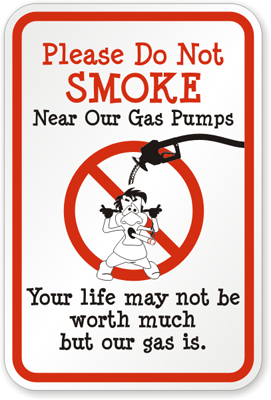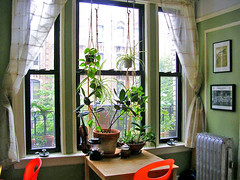Guest post by Victoria Brown
We live in a time where we are becoming a more environmentally conscious society than ever before. Each day, many of us take small steps to conserve resources and protect the health of our families and homes. We are becoming more conscious about what we bring into our homes, but it is just as important to be aware of what lies just outside of our homes that could affect our indoor air quality. Knowing the historical and present landscape of our neighborhood can bring awareness to some of the potential risks we may be at when it comes to the air quality in our homes. Below are some landscape features to get you thinking about your neighborhood environment, whether or not there is a risk for indoor air pollution in your home and if so, how one can mitigate any potential problems.
Landfill and Wetlands

Gas station (Photo credits: www.mysafetysign.com)
Landfills and wetlands may be two very contrasting landscapes, but they both produce a lot of methane. Methane, also known as “natural gas,” is created during the process of decomposition of organic matter, which is the primary business of both landfills and wetlands. Methane is also found in homes with gas-powered stoves and heating systems. Methane makes up approximately 17% of the air we breathe; however, methane presents a dangerous problem if it accumulates in large concentrations within an enclosed structure. Due to its highly flammable nature, high concentrations of methane can pose a risk for explosion.
Active or Historical Oil Well
Depending on the region, oil exploration may make up a large part of your region’s history. States such as California and Texas have histories rich with oil exploration. Areas such as Marina Del Rey and Huntington Beach in Southern California are sites that formerly had been areas with extensive oil exploration, and are now mostly residential. When oil exploration first began, some oil wells were abandoned incorrectly, leaving a direct route for methane to escape to the surface. How can you find out if your home is near a historic or active oil well, and whether or not you are at risk for methane build-up in your home?
How much methane is too much methane?
Methane ordinance maps vary between each state, county and city. Once located, it is easy to see if your neighborhood is in a methane zone or methane buffer zone. For example, for unincorporated Los Angeles County, one can find this information at this site Solid Waste Information Management System County of Los Angeles Department of Public Works
Make sure you check to see if your city has its own methane ordinance. If the subject property is in Culver City for example, you would check with the individual city for their specific methane ordinance permit.
If it turns out that your property lies within a methane zone or methane buffer zone, testing for abnormal concentrations can be done by an environmental consultant.
Locating Historic Oil Wells
Sources of information vary from state to state; for example, in California, you can access maps with plotted active and historical wells. If the test results depict high levels of methane within your property, an environmental consultant can assist in designing a methane mitigation system.
Gas Stations and Dry Cleaners
Gas stations are so commonly part of our daily landscape that oftentimes we do not reflect on how it may have negative consequences on our health. Pollution derived from gas stations may affect our homes if we live within a quarter mile of one. Modern gas stations are designed with preventative environmental impact measures, but the reality is that many gas stations have been around for several decades and may have had issues with leaking underground storage tanks or spills. Gas stations tend to house a variety of volatile organic compounds (VOCs), substances like hydrocarbons that are gaseous and dangerous.
Although gasoline itself is not a carcinogen, many of the additives are, such as benzene. If there was an incident where one of the underground storage tanks leaked, seeping into the soil and groundwater, there is a possibility that neighboring properties could be affected.
Identifying a contaminated gas station
There are several resources available to the public that make it easy to find out whether or not your neighborhood gas station has had a reported pollution release. You can search for more information using resources like environmentalpollutioncenters.org or search by zip code.
Like gas stations, dry cleaners are also part of our daily landscape. Dry cleaners, especially older operations, handle many hazardous materials. The two main contaminants associated with dry cleaners are Perchloroethylene (PCE) and Trichloroethylene (TCE).These are chlorinated solvents which if not handled properly, can quickly affect the soil and groundwater of the property and adjacent properties.
You can search your zip code to verify whether the dry cleaners in your neighborhood are within compliance or are having issues with contamination. If it turns out that there is a contaminated dry cleaning operation or gas station near by, you want to be sure the vapors are not entering your home. One way to test for this is to do a Soil Vapor Encroachment Study, conducted by an environmental consultant, to determine whether or not there is a possibility of vapors accumulating inside your home.
If, after doing a Soil Vapor Encroachment Study, it is determined that there are vapors present inside your home, there is a variety of reasonable options for mitigating the vapors.
Asbestos and Lead: Was your home built before 1980?
Asbestos and lead-based paint are commonly found in households built prior to 1980. Asbestos containing materials are used in ceiling acoustics, flooring adhesive, and pipe insulation, to name a few. Lead-based paint and asbestos containing materials are only a hazard if they are disturbed. Young children, pregnant women, and the elderly are the most sensitive to asbestos and lead exposure. If you have deterioration on the walls, ceiling or floors, or plan to renovate, in order to negate airborne contaminated dust, you can either hire an inspector to test the material, and a contractor to abate it, or if you do it yourself, wearing an N-95 mask is recommended to avoid breathing in potentially contaminated dust.
Asbestos and Lead Mitigation Hazardous material abatement by a professional will usually entail sealing off the area with tarp so as to limit the potential for contaminated dust entering other areas. Professionals will also finish by clearing the area with a special vacuum cleaner; regular vacuum cleaners are not affective for asbestos removal and will expel the asbestos fibers into the air.
There are many features in our neighborhood environments that we may not realize are harming us. The colorless and odorless nature of methane and the elusive, often underground movement of PCE and gasoline additives, all make it difficult to identify an environmental issue by sight or smell. Fortunately, information regarding environmental contamination and risk is fairly transparent due to regulatory oversight, allowing you to best prepare your home to be a safe and healthy environment.



















